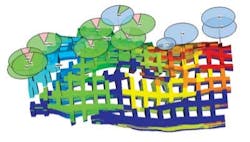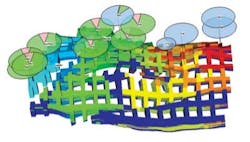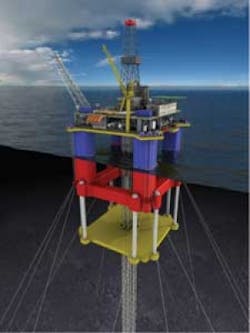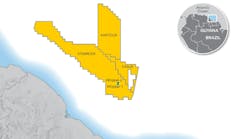Upcoming South Stream project in Black Sea calls for 560 mi of 32-in. pipe in depths to 7,200 ft
Martijn van Driel
Alex Mayants
Intecsea BV
Alexey Serebryakov
OAO Gazprom
Andrey Sergienko
OAO Giprospetsgaz
Gazprom has successfully realized some of the world's largest offshore gas transportation systems, with pipelines in the 24-in. (61-cm) diameter range traversing water depths of more than 2,100 m (6,889 ft) with the Blue Stream I and II projects.
Now, with South Stream, project planners are considering the challenges of installing 32-in. (81-cm) diameter pipeline in depths that will exceed 2,200 m (7,200 ft). The 900-km (560-mi) pipeline will extend from the Russian coast to a western landfall on either the Bulgarian or Romanian coastline. Some of the key challenges include:
- Water depths exceeding 2,200 m (7,200 ft)
- Relatively large pipeline diameter for given water depth
- Difficult seabed conditions with steep slopes and geohazards
- Potentially aggressive/corrosive subsea environments.
The complexity of an offshore pipeline typically is expressed in terms of the water depth and diameter. While these are not the only drivers for a project's complexity, this expression does provide a good insight in the position of a project in relation to the current status of the industry.
While a 24-in. pipeline in 2,150 m (7,053 ft) as installed for Blue Stream in 2003 was a major challenge at the time, that project did lead to the development of technology that is now considered proven, and similar projects have been realized in various regions in the world. With projects like South Stream, the industry is now exploring a new frontier and preparing for the next step.
Seabed conditions
Pipelines across the Black Sea need to traverse a deep abyssal plain bordered by steep and sometimes rugged continental slopes. While the deepwater of the abyssal plain leads to a high external pressure, which is important for the wall thickness requirement, the continental slope crossings also can be challenging, often with high risk of pipeline spanning and geohazards.
In deepwater, the current and wave effects are limited, causing little dynamic loading. Allowable pipeline spans are typically longer than in shallow water and governed by local buckling criteria. Excessive spans can be corrected either by shoulder shaving, support placements, or combination thereof; the tooling for both seabed intervention methods has been developed and is available.
Geohazards are defined as features of the natural seabed that threaten the integrity of submarine pipeline systems. Such features include submarine channels, faulting, unstable slopes, landslides, mud volcanoes, seabed hydrates, pockmarks, debris, and turbidity flows.
Historically, the risk posed by such features has been eliminated often simply by routing around them. However, for pipelines crossing a continental slope into deepwater, it becomes less likely that all such potential hazards can be avoided. Hence, engineering solutions must take into account the underlying geological and/or sediment movement processes.
Geohazards can lead to significant loads on or displacements of a pipeline. In the Black Sea, the most relevant geohazards include:
- Faults
- Unstable slopes resulting in slumps or slides
- Mudflows / mass gravity flows
- Earthquake or wave induced liquefaction in the shore approach area
- Mud volcanoes
- Gas-expulsion features.
All of the above features have been identified in the project area, and need to be addressed through rigorous survey and engineering. Earthquake-induced slope stability and mass gravity flows could pose a significant risk to the integrity of the pipeline at the Russian continental slope, and a similar situation exists for the western continental margin. An extensive feasibility survey has been performed to identify these risks and to develop preliminary route options. To further quantify these risks, it is important to perform a comprehensive design survey campaign to capture and analyze these geohazards. This can save a significant amount of time/costs on subsequent detailed surveys, studies, and construction.
It is one of the best-known Black Sea properties: deeper than approximately 150 to 200 m (490 to 656 ft), Black Sea water does not contain oxygen, but does contain dissolved sulfuric hydride. Water mixing (driven by currents and waves) is needed for the oxygen captured from air and generated by algae at the sea surface to reach lower layers of the sea. In the Black Sea, there is extremely little vertical water mixing, resulting in the world's largest stratified water body.
For the Blue Stream project, the environment of the Black Sea was classified as sour (or “H2S containing”) based on extensive measurement campaigns and supported by historical research data that showed accelerated corrosion rates in parts of the Black Sea environment. The likely cause of the corrosion was identified as a combination of H2S and sulphate reducing bacteria (SRB). Detailed water and soil tests are being performed for the South Stream project to establish the chemistry of the Black Sea environment over the vertical water column, as well as the top soil to a depth of 4 to 6 m (13 to 19.7 ft) below the seabed surface.
Contrary to normal sour service pipelines in which sour medium is introduced inside of the pipe, the Black Sea environment may cause H2S exposure to the outer surface of the pipe. This service condition applies over the system lifetime. It is difficult to quantify, since it depends on highly localized soil conditions and pipe/soil/water chemical interactions over the complete length and lifetime of the system. When present, high H2S concentration is typically found at a depth of 2 to 4 m (6.5 to 13 ft) below the seabed. Its effects on the pipe steel and welds are being investigated.
Since there are no concepts readily available to mitigate an external H2S-containing environment after pipeline operation, it is essential to correctly assess the associated risks and costs. For South Stream, this issue is being investigated in detail through an extensive geochemical survey and analysis program, as well as a detailed material testing and development program.
Hydraulic performance
For a project like South Stream, the investment involved is considerable and the ability to transport significantly more gas at limited additional cost improves the commercial performance of the project. Hence, an increase in diameter has significant benefits for the project economics, enabling more gas to be transported over longer distances. As part of project analysis, planners have examined the typical relationship between inlet pressure and outside diameter for different throughputs for a 900-km (560-mi) pipeline. The research showed that a diameter increase from 24 to 32-in. allows twice the volume of gas to be transported. While the friction loss increases exponentially for smaller diameters, it also increases with the higher velocities required to transport the same volume through a smaller pipe. While this figure only relates to a typical pipeline length, the same considerations apply for shorter distance pipelines, justifying the desire to implement larger diameter pipelines for deep water application. For inlet pressure requirements up to 30 MPa (4,350 psi), the application of existing and field proven technologies is available. No technology gap is foreseen.
For pipelines as long as South Stream, the minimum allowable arrival temperature requirement can become the governing factor rather than the pressure loss. The gas cools when ascending the continental slope and passing through the buried shore approach section on the receiving end. Good knowledge of pipeline settlement (and therefore soil conditions) and concrete coating becomes important to accurately predict the hydraulic performance of the system. In case that the in-situ sediment at the downstream shore approach is found to be susceptible to frost heave, it would be wise to consider engineered backfill.
The parameter that strongly influences the system's thermo-hydraulic performance is the embedment on the continental shelf at the receiving end. Overall, embedment in the soft, often liquid clay of the Black Sea can easily be 50 to 100% or more of the diameter. Thermo-hydraulic performance is verified against existing operational information to provide additional certainty; given the importance of pipe burial, the hydraulic analyses will be revisited after geotechnical survey results are obtained and pipe burial has been calculated.
Another parameter influencing the receiving temperature is the application of concrete coating. Concrete coating provides a thermal insulation in comparison to an uncoated pipe. One option being considered is to continue the deepwater wall thickness up to the receiving landfall, thereby reducing the extent of concrete coated pipe. While this would most likely result in a higher capex, the overall throughput capacity could be improved.
Steel grade selection
It is generally practical to apply the highest possible line pipe grade to minimize the wall thickness, weight, and cost of the pipeline. For deepwater offshore applications, DNV SAWL 450 has been used in numerous sour and non-sour conditions. DNV SAWL 485 grade has been produced almost exclusively for non-sour service, although recent developments and trials in sour service conditions have been initiated for small-diameter pipelines. Nevertheless, additional qualifications for H2S-resistant application are required to ensure the performance of DNV SAWL 485.
Installability
The combination of pipeline diameter and maximum water depth for South Stream exceeds that previously achieved in the worldwide pipeline industry. The first issue to be addressed in terms of overall construction feasibility is, therefore, the ability to install the selected pipeline dimensions in the deepwater segment of the route.
Furthermore, the significant route length introduces additional challenges to maximize installation efficiency. Installation of the pipeline will require extension of the existing global pipelay installation capacity. In doing so, the success factors and experiences from previous record-setting pipeline projects such as Blue Stream and Nord Stream must be evaluated and applied where appropriate.
The feasibility of the installation of the deepwater section of the route governs the overall system construction feasibility. As part of this process, the capabilities of the existing deepwater pipeline installation vessels are being assessed against the deepwater installation requirements on this project. The three existing deepwater pipeline installation vessels usually considered suitable for a project like South Stream are the SaipemS7000, Allseas Solitaire, and HMC Balder. Furthermore, the deepwater installation capacity will increase in the future if several newbuild vessels are completed on schedule. These include the Saipem FDS-2 and Castorone; the Allseas PieterSchelte,and a new vessel being developed by Hereema Marine Contractors (HMC). In general, it has been concluded that installation is feasible using the existing deepwater installation vessel fleet. However, the assessment of the existing three deepwater pipeline installation vessels shows that all three vessels will require some modifications/upgrades to install the South Stream system safely and efficiently.
Wall thickness
Core to the capability to develop large diameter projects in deepwater is the wall thickness design in combination with the manufacturability of the linepipe.
Full-scale collapse test pipe.
For the pipe diameter and wall thickness under discussion, only two pipe manufacturing processes are feasible: JCOE and UOE.
In the JCOE process, the plate is formed to a J-shape using a pressed module, step-by-step at a fixed width interval. Then using a similar method, the plate is formed to a C-shape until it obtains an O-shape. The pipe is subjected to cold expansion after tack weld and submerged arc welded at the inside and outside parts.
The UOE process consists of forming the plate into U-shape and O-shape using a pressed module, followed by tack weld and longitudinal weld of the pipe. As opposed to the JCOE process, both the U-shape and O-shape are obtained using one-step forming. Thereafter the pipe is cold expanded to obtain the required dimension. For both pipe manufacturing methods, the current DNV code formulation results in a reduction of the compressive strength after the manufacturing process, with 15% compared with tensile strength.
The wall thickness required for South Stream is at the limit of the leading mills' capability. One limitation for some mills is the capacity of the pipe-forming process (such as the capacity of the O-press). While this restriction may be avoided through a considerable investment in upgrade of the mill, the control of pipe properties in the weld area for such thick-walled pipes remains a major issue (in particular parameters such as ductility and toughness). For deepwater application, these pipe properties are critical to the pipe performance. Achieving the desired material parameters for the wall thickness required using standard calculation methods is on the edge of what can be produced. A small reduction in wall thickness can result in a major improvement in manufacturability, and thereby drive the actual feasibility of the project for a specific throughput and OD combination.
For the deepwater section of the pipeline, the design is governed by the local buckling criterion. This condition occurs during installation at the pipeline sagbend where the pipeline will experience the most extreme combination of external pressure and bending. In the calculation of the required wall thickness for this design limit state, the following critical technological advances can be applied:
- Recovery of collapse resistance through thermal aging
- Tighter dimensional control on line pipe manufacture
- Tight control on bending strain during installation
- A partly displacement-controlled condition is applied in the design for the sagbend.
The largest contribution to wall thickness optimization is from the recovery of collapse resistance through thermal aging. Pipe collapse resistance is linked to the pipe hoop compressive strength. Many studies including small-scale and full-scale tests have been performed in the past 20 years (for example Oman-India, Blue Stream, and Mardi Gras), evidencing that a significant recovery in collapse strength can be gained for DNV SAWL 450 steel (in the order of 30%). In fact, test results suggest the collapse resistance is recovered even beyond the original value.
Using the current DNV F101 formulation, most mills, nowadays, indicate that they are able to produce pipe with a significantly improved fabrication factor, incorporating strength recovery through thermal aging. Thermal aging effect is the ability of steel to recover its strength due to strain aging. It is possible to take advantage of thermal aging through application of external coating, which usually takes place at the same temperature range as where the thermal aging process occurs.
For a deepwater, large-diameter pipeline such as South Stream, using a thinner wall without compromising system reliability is desirable not only for the obvious economics in steel saving but also out of necessity, as blind compliance to the current international design codes would result in a wall thickness that is beyond manufacturability.
To give the owner, designer, and manufacturer sufficient confidence, Gazprom has commissioned a full testing program, which is currently ongoing. This testing program includes full scale testing of as-received and thermally treated pipe joints, subjected to combined loading of external pressure and bending.
Deepwater repair contingencies
In the past, even though the probability of failure of a properly planned deepwater pipeline is small, the risk associated has been a concern because of the difficulties in making repairs. While the effort required remains considerable, current deepwater technology provides the tooling that allows repairs large-diameter, deepwater pipelines. Even within the region, repair systems are available for the water depth (Blue Stream) or diameter (Green Stream) under discussion. To combine these into a new application is relatively straightforward, with little technology gap.
Conclusions
A 24-in. pipeline in 2,150-m water depth or 32-in. pipelines in 1,400-m water depth are accepted by the offshore industry as proven technologies. The South Stream project is now investigating the feasibility of using larger diameters (such as 32-in.) in 2,200-m-plus water depths, and its successful construction will be another step-change for the offshore industry. The use of a larger diameter will provide obvious benefits for the project economics, allowing a considerably higher throughput; but this requires an advance application of existing technologies.
For the present installation fleet, the installability of such a pipeline is complex but not governing. This capability will be further improved if the currently scheduled deepwater installation vessels are completed on schedule. Still, rigorous design is essential, regardless of the selected diameter.
Key to the success of such projects is the manufacturability of the line pipe with the requisite wall thickness. The wall thickness required for large-diameter pipelines is on the edge of leading mills' capabilities. Several technology advances need to be applied to achieve feasibility, and a rigorous development program is ongoing for successful implementation.
Acknowledgment
Based on a paper presented at the Deep Offshore Technology International Conference and Exhibition held on Nov. 30-Dec. 2, 2010, in Amsterdam.
Offshore Articles Archives
View Oil and Gas Articles on PennEnergy.com








